Informatics Module: An Analysis of Additive Manufacturing Report
VerifiedAdded on 2020/05/01
|11
|2417
|87
Report
AI Summary
This report provides an in-depth analysis of additive manufacturing, also known as 3D printing, exploring its transformative impact on the production industry. The report begins with an introduction to the technology, explaining its process of adding material layer by layer, and then discusses its suitability for low-volume production, highlighting its cost-effectiveness compared to traditional methods. It then delves into valuable applications across industries such as medical, military, and automotive, emphasizing the technology's ability to create complex and precise components. The report further examines the future forecast of additive manufacturing, predicting significant growth and its potential to revolutionize the manufacturing sector, making it accessible to consumers. The report concludes with recommendations for companies to invest in this technology, emphasizing its benefits and impact on consumers. It references various sources to support its claims and provides a comprehensive overview of additive manufacturing's potential and current state.

Running head: ADDITIVE MANUFACTURING
0
Introduction to Informatics
0
Introduction to Informatics
Paraphrase This Document
Need a fresh take? Get an instant paraphrase of this document with our AI Paraphraser
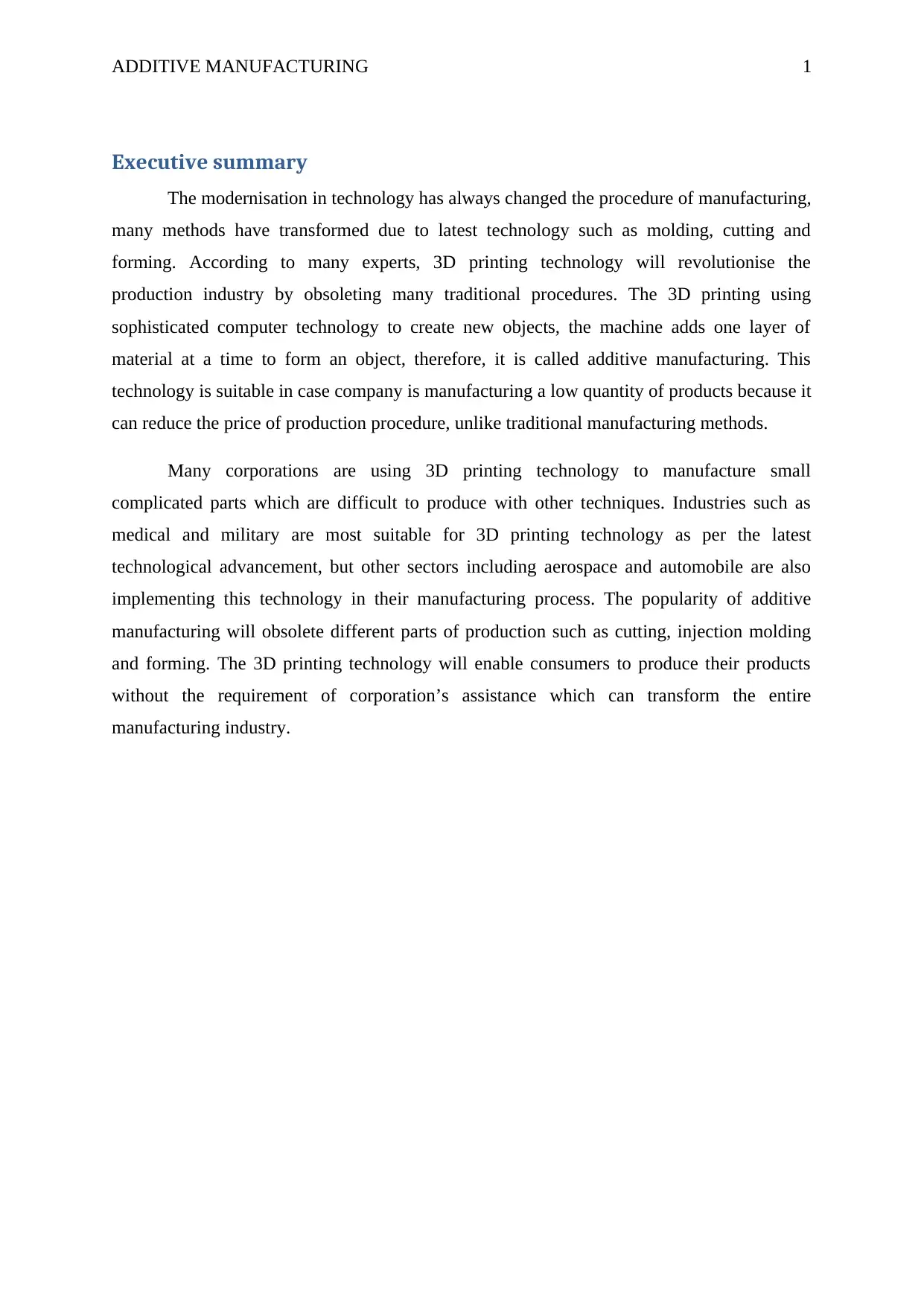
ADDITIVE MANUFACTURING 1
Executive summary
The modernisation in technology has always changed the procedure of manufacturing,
many methods have transformed due to latest technology such as molding, cutting and
forming. According to many experts, 3D printing technology will revolutionise the
production industry by obsoleting many traditional procedures. The 3D printing using
sophisticated computer technology to create new objects, the machine adds one layer of
material at a time to form an object, therefore, it is called additive manufacturing. This
technology is suitable in case company is manufacturing a low quantity of products because it
can reduce the price of production procedure, unlike traditional manufacturing methods.
Many corporations are using 3D printing technology to manufacture small
complicated parts which are difficult to produce with other techniques. Industries such as
medical and military are most suitable for 3D printing technology as per the latest
technological advancement, but other sectors including aerospace and automobile are also
implementing this technology in their manufacturing process. The popularity of additive
manufacturing will obsolete different parts of production such as cutting, injection molding
and forming. The 3D printing technology will enable consumers to produce their products
without the requirement of corporation’s assistance which can transform the entire
manufacturing industry.
Executive summary
The modernisation in technology has always changed the procedure of manufacturing,
many methods have transformed due to latest technology such as molding, cutting and
forming. According to many experts, 3D printing technology will revolutionise the
production industry by obsoleting many traditional procedures. The 3D printing using
sophisticated computer technology to create new objects, the machine adds one layer of
material at a time to form an object, therefore, it is called additive manufacturing. This
technology is suitable in case company is manufacturing a low quantity of products because it
can reduce the price of production procedure, unlike traditional manufacturing methods.
Many corporations are using 3D printing technology to manufacture small
complicated parts which are difficult to produce with other techniques. Industries such as
medical and military are most suitable for 3D printing technology as per the latest
technological advancement, but other sectors including aerospace and automobile are also
implementing this technology in their manufacturing process. The popularity of additive
manufacturing will obsolete different parts of production such as cutting, injection molding
and forming. The 3D printing technology will enable consumers to produce their products
without the requirement of corporation’s assistance which can transform the entire
manufacturing industry.
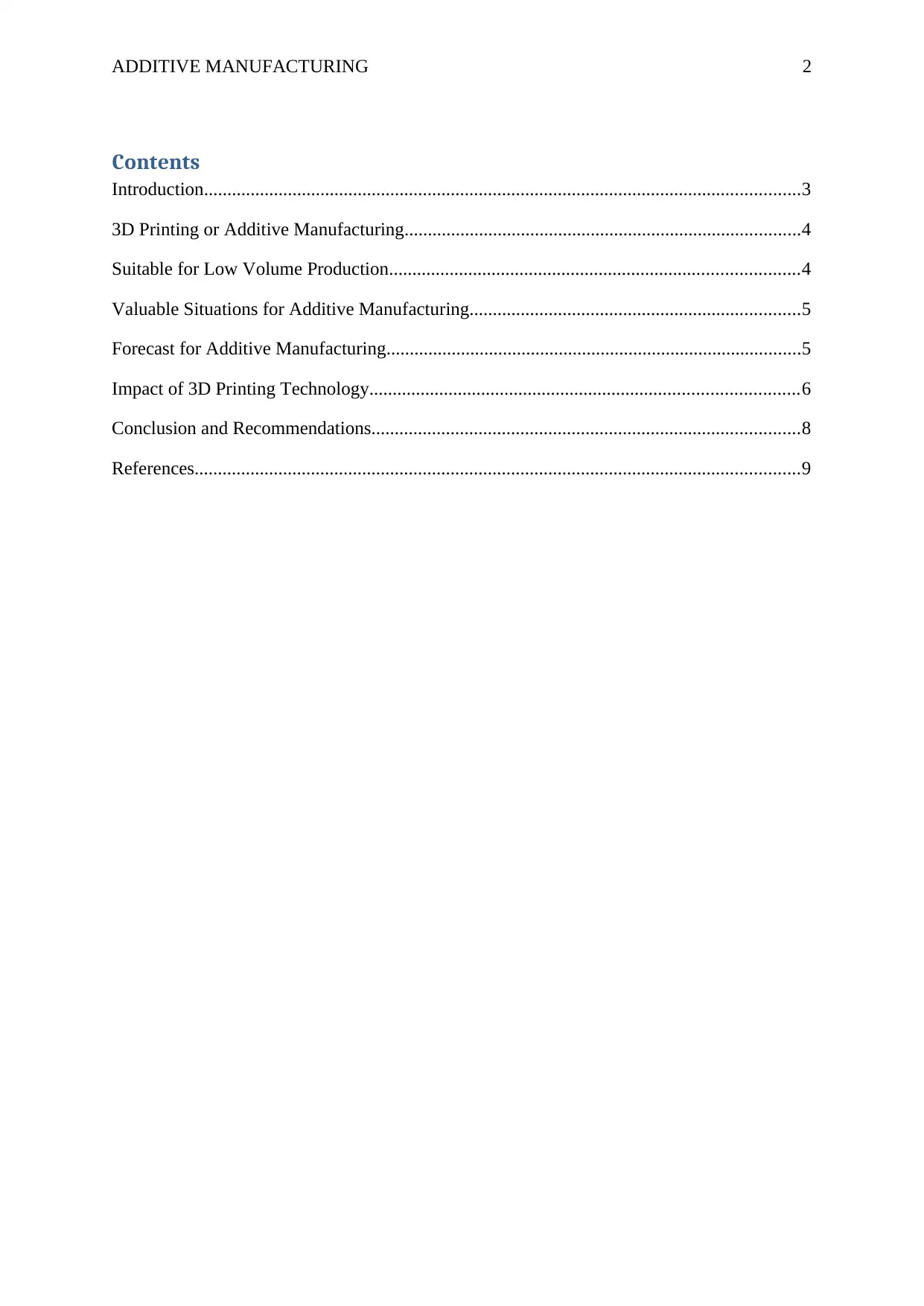
ADDITIVE MANUFACTURING 2
Contents
Introduction................................................................................................................................3
3D Printing or Additive Manufacturing.....................................................................................4
Suitable for Low Volume Production........................................................................................4
Valuable Situations for Additive Manufacturing.......................................................................5
Forecast for Additive Manufacturing.........................................................................................5
Impact of 3D Printing Technology............................................................................................6
Conclusion and Recommendations............................................................................................8
References..................................................................................................................................9
Contents
Introduction................................................................................................................................3
3D Printing or Additive Manufacturing.....................................................................................4
Suitable for Low Volume Production........................................................................................4
Valuable Situations for Additive Manufacturing.......................................................................5
Forecast for Additive Manufacturing.........................................................................................5
Impact of 3D Printing Technology............................................................................................6
Conclusion and Recommendations............................................................................................8
References..................................................................................................................................9
⊘ This is a preview!⊘
Do you want full access?
Subscribe today to unlock all pages.

Trusted by 1+ million students worldwide
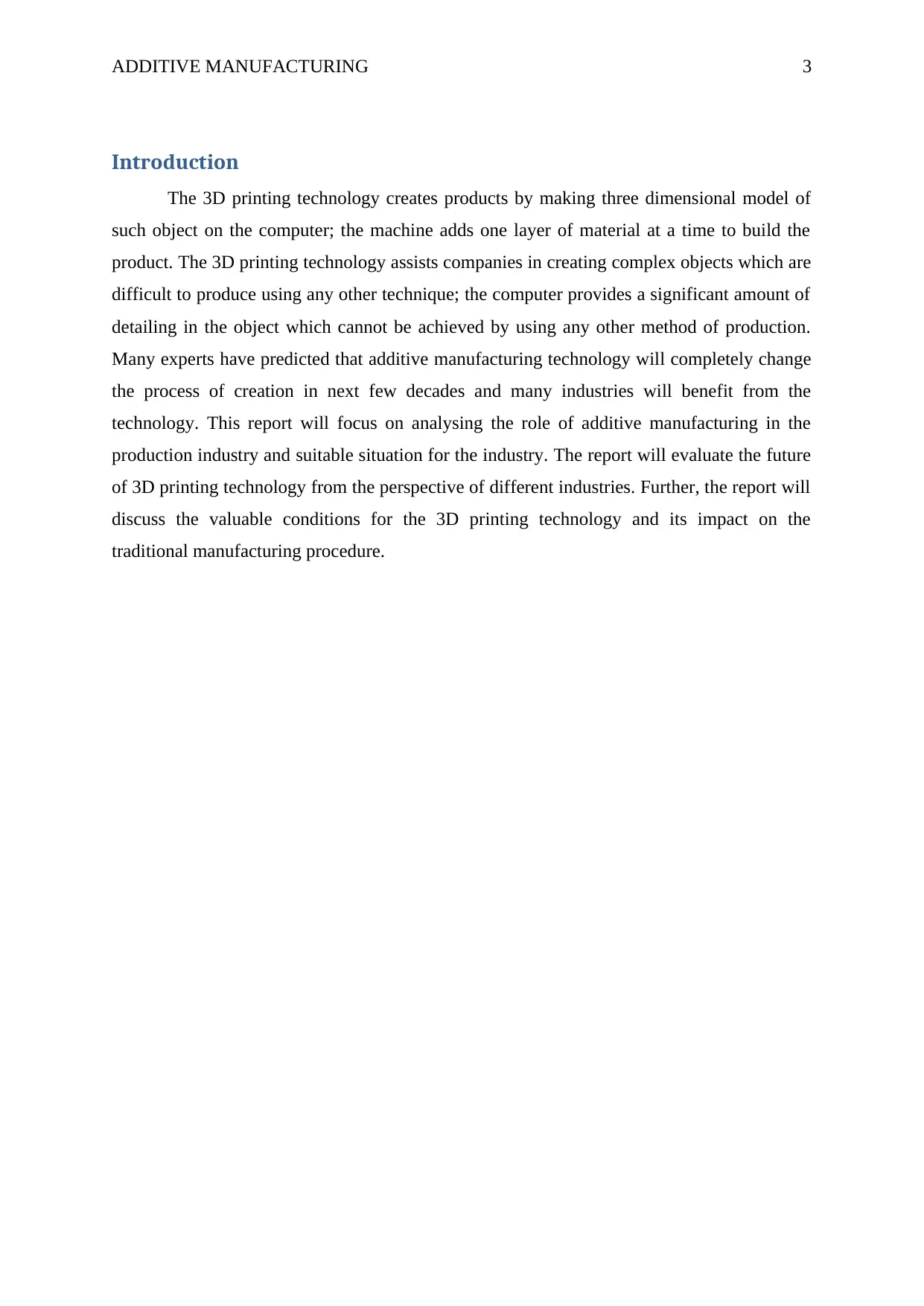
ADDITIVE MANUFACTURING 3
Introduction
The 3D printing technology creates products by making three dimensional model of
such object on the computer; the machine adds one layer of material at a time to build the
product. The 3D printing technology assists companies in creating complex objects which are
difficult to produce using any other technique; the computer provides a significant amount of
detailing in the object which cannot be achieved by using any other method of production.
Many experts have predicted that additive manufacturing technology will completely change
the process of creation in next few decades and many industries will benefit from the
technology. This report will focus on analysing the role of additive manufacturing in the
production industry and suitable situation for the industry. The report will evaluate the future
of 3D printing technology from the perspective of different industries. Further, the report will
discuss the valuable conditions for the 3D printing technology and its impact on the
traditional manufacturing procedure.
Introduction
The 3D printing technology creates products by making three dimensional model of
such object on the computer; the machine adds one layer of material at a time to build the
product. The 3D printing technology assists companies in creating complex objects which are
difficult to produce using any other technique; the computer provides a significant amount of
detailing in the object which cannot be achieved by using any other method of production.
Many experts have predicted that additive manufacturing technology will completely change
the process of creation in next few decades and many industries will benefit from the
technology. This report will focus on analysing the role of additive manufacturing in the
production industry and suitable situation for the industry. The report will evaluate the future
of 3D printing technology from the perspective of different industries. Further, the report will
discuss the valuable conditions for the 3D printing technology and its impact on the
traditional manufacturing procedure.
Paraphrase This Document
Need a fresh take? Get an instant paraphrase of this document with our AI Paraphraser
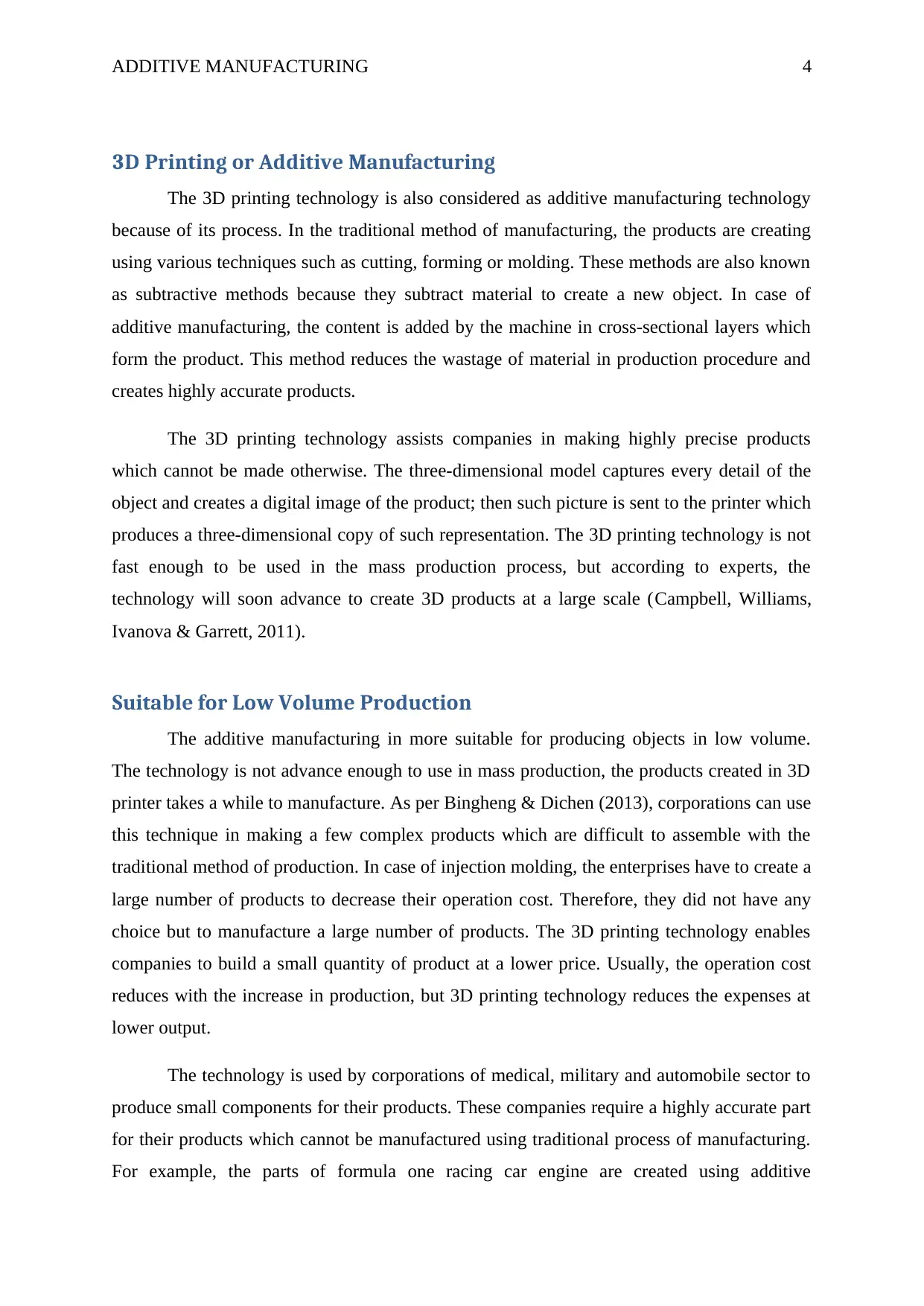
ADDITIVE MANUFACTURING 4
3D Printing or Additive Manufacturing
The 3D printing technology is also considered as additive manufacturing technology
because of its process. In the traditional method of manufacturing, the products are creating
using various techniques such as cutting, forming or molding. These methods are also known
as subtractive methods because they subtract material to create a new object. In case of
additive manufacturing, the content is added by the machine in cross-sectional layers which
form the product. This method reduces the wastage of material in production procedure and
creates highly accurate products.
The 3D printing technology assists companies in making highly precise products
which cannot be made otherwise. The three-dimensional model captures every detail of the
object and creates a digital image of the product; then such picture is sent to the printer which
produces a three-dimensional copy of such representation. The 3D printing technology is not
fast enough to be used in the mass production process, but according to experts, the
technology will soon advance to create 3D products at a large scale (Campbell, Williams,
Ivanova & Garrett, 2011).
Suitable for Low Volume Production
The additive manufacturing in more suitable for producing objects in low volume.
The technology is not advance enough to use in mass production, the products created in 3D
printer takes a while to manufacture. As per Bingheng & Dichen (2013), corporations can use
this technique in making a few complex products which are difficult to assemble with the
traditional method of production. In case of injection molding, the enterprises have to create a
large number of products to decrease their operation cost. Therefore, they did not have any
choice but to manufacture a large number of products. The 3D printing technology enables
companies to build a small quantity of product at a lower price. Usually, the operation cost
reduces with the increase in production, but 3D printing technology reduces the expenses at
lower output.
The technology is used by corporations of medical, military and automobile sector to
produce small components for their products. These companies require a highly accurate part
for their products which cannot be manufactured using traditional process of manufacturing.
For example, the parts of formula one racing car engine are created using additive
3D Printing or Additive Manufacturing
The 3D printing technology is also considered as additive manufacturing technology
because of its process. In the traditional method of manufacturing, the products are creating
using various techniques such as cutting, forming or molding. These methods are also known
as subtractive methods because they subtract material to create a new object. In case of
additive manufacturing, the content is added by the machine in cross-sectional layers which
form the product. This method reduces the wastage of material in production procedure and
creates highly accurate products.
The 3D printing technology assists companies in making highly precise products
which cannot be made otherwise. The three-dimensional model captures every detail of the
object and creates a digital image of the product; then such picture is sent to the printer which
produces a three-dimensional copy of such representation. The 3D printing technology is not
fast enough to be used in the mass production process, but according to experts, the
technology will soon advance to create 3D products at a large scale (Campbell, Williams,
Ivanova & Garrett, 2011).
Suitable for Low Volume Production
The additive manufacturing in more suitable for producing objects in low volume.
The technology is not advance enough to use in mass production, the products created in 3D
printer takes a while to manufacture. As per Bingheng & Dichen (2013), corporations can use
this technique in making a few complex products which are difficult to assemble with the
traditional method of production. In case of injection molding, the enterprises have to create a
large number of products to decrease their operation cost. Therefore, they did not have any
choice but to manufacture a large number of products. The 3D printing technology enables
companies to build a small quantity of product at a lower price. Usually, the operation cost
reduces with the increase in production, but 3D printing technology reduces the expenses at
lower output.
The technology is used by corporations of medical, military and automobile sector to
produce small components for their products. These companies require a highly accurate part
for their products which cannot be manufactured using traditional process of manufacturing.
For example, the parts of formula one racing car engine are created using additive
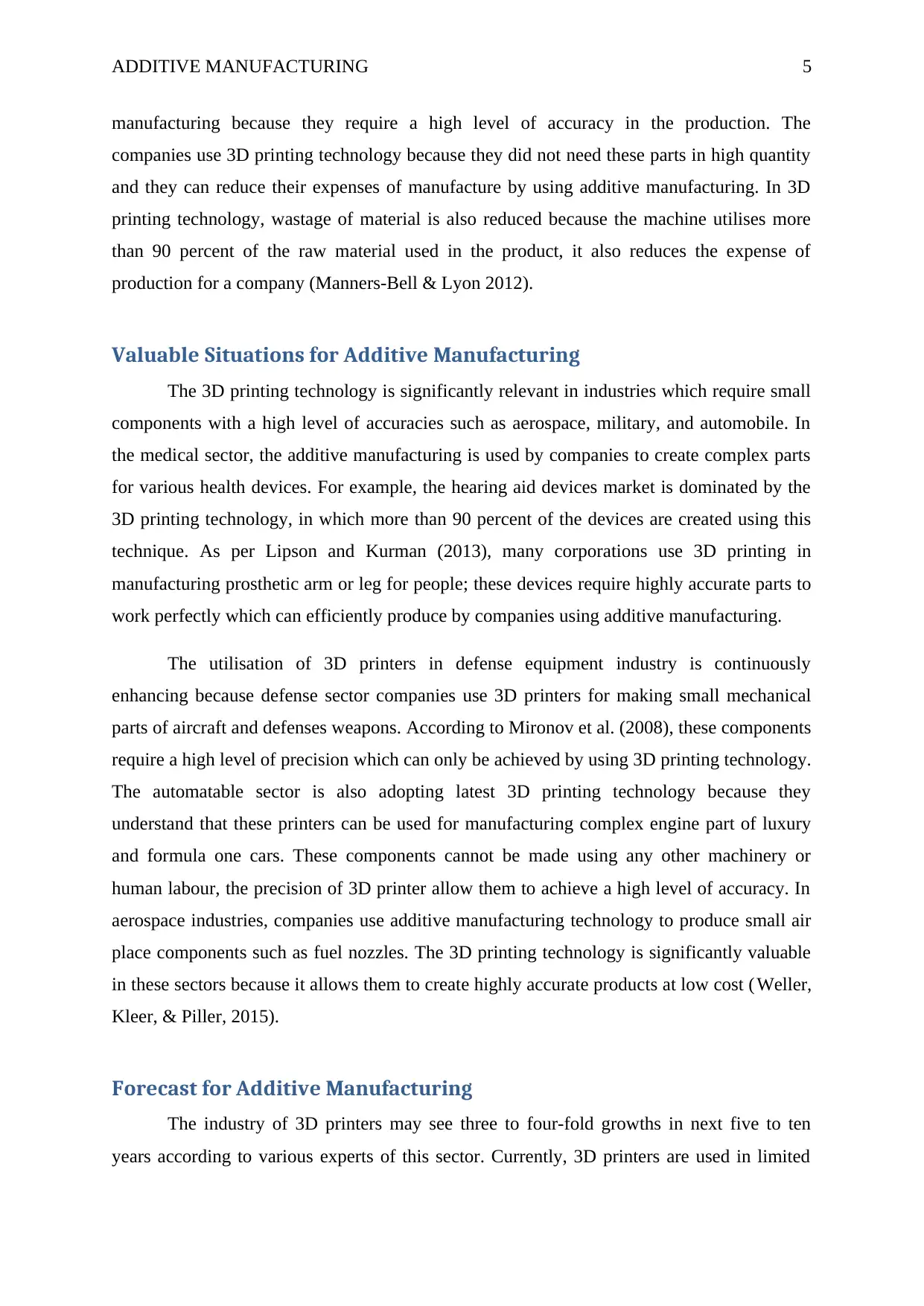
ADDITIVE MANUFACTURING 5
manufacturing because they require a high level of accuracy in the production. The
companies use 3D printing technology because they did not need these parts in high quantity
and they can reduce their expenses of manufacture by using additive manufacturing. In 3D
printing technology, wastage of material is also reduced because the machine utilises more
than 90 percent of the raw material used in the product, it also reduces the expense of
production for a company (Manners-Bell & Lyon 2012).
Valuable Situations for Additive Manufacturing
The 3D printing technology is significantly relevant in industries which require small
components with a high level of accuracies such as aerospace, military, and automobile. In
the medical sector, the additive manufacturing is used by companies to create complex parts
for various health devices. For example, the hearing aid devices market is dominated by the
3D printing technology, in which more than 90 percent of the devices are created using this
technique. As per Lipson and Kurman (2013), many corporations use 3D printing in
manufacturing prosthetic arm or leg for people; these devices require highly accurate parts to
work perfectly which can efficiently produce by companies using additive manufacturing.
The utilisation of 3D printers in defense equipment industry is continuously
enhancing because defense sector companies use 3D printers for making small mechanical
parts of aircraft and defenses weapons. According to Mironov et al. (2008), these components
require a high level of precision which can only be achieved by using 3D printing technology.
The automatable sector is also adopting latest 3D printing technology because they
understand that these printers can be used for manufacturing complex engine part of luxury
and formula one cars. These components cannot be made using any other machinery or
human labour, the precision of 3D printer allow them to achieve a high level of accuracy. In
aerospace industries, companies use additive manufacturing technology to produce small air
place components such as fuel nozzles. The 3D printing technology is significantly valuable
in these sectors because it allows them to create highly accurate products at low cost (Weller,
Kleer, & Piller, 2015).
Forecast for Additive Manufacturing
The industry of 3D printers may see three to four-fold growths in next five to ten
years according to various experts of this sector. Currently, 3D printers are used in limited
manufacturing because they require a high level of accuracy in the production. The
companies use 3D printing technology because they did not need these parts in high quantity
and they can reduce their expenses of manufacture by using additive manufacturing. In 3D
printing technology, wastage of material is also reduced because the machine utilises more
than 90 percent of the raw material used in the product, it also reduces the expense of
production for a company (Manners-Bell & Lyon 2012).
Valuable Situations for Additive Manufacturing
The 3D printing technology is significantly relevant in industries which require small
components with a high level of accuracies such as aerospace, military, and automobile. In
the medical sector, the additive manufacturing is used by companies to create complex parts
for various health devices. For example, the hearing aid devices market is dominated by the
3D printing technology, in which more than 90 percent of the devices are created using this
technique. As per Lipson and Kurman (2013), many corporations use 3D printing in
manufacturing prosthetic arm or leg for people; these devices require highly accurate parts to
work perfectly which can efficiently produce by companies using additive manufacturing.
The utilisation of 3D printers in defense equipment industry is continuously
enhancing because defense sector companies use 3D printers for making small mechanical
parts of aircraft and defenses weapons. According to Mironov et al. (2008), these components
require a high level of precision which can only be achieved by using 3D printing technology.
The automatable sector is also adopting latest 3D printing technology because they
understand that these printers can be used for manufacturing complex engine part of luxury
and formula one cars. These components cannot be made using any other machinery or
human labour, the precision of 3D printer allow them to achieve a high level of accuracy. In
aerospace industries, companies use additive manufacturing technology to produce small air
place components such as fuel nozzles. The 3D printing technology is significantly valuable
in these sectors because it allows them to create highly accurate products at low cost (Weller,
Kleer, & Piller, 2015).
Forecast for Additive Manufacturing
The industry of 3D printers may see three to four-fold growths in next five to ten
years according to various experts of this sector. Currently, 3D printers are used in limited
⊘ This is a preview!⊘
Do you want full access?
Subscribe today to unlock all pages.

Trusted by 1+ million students worldwide
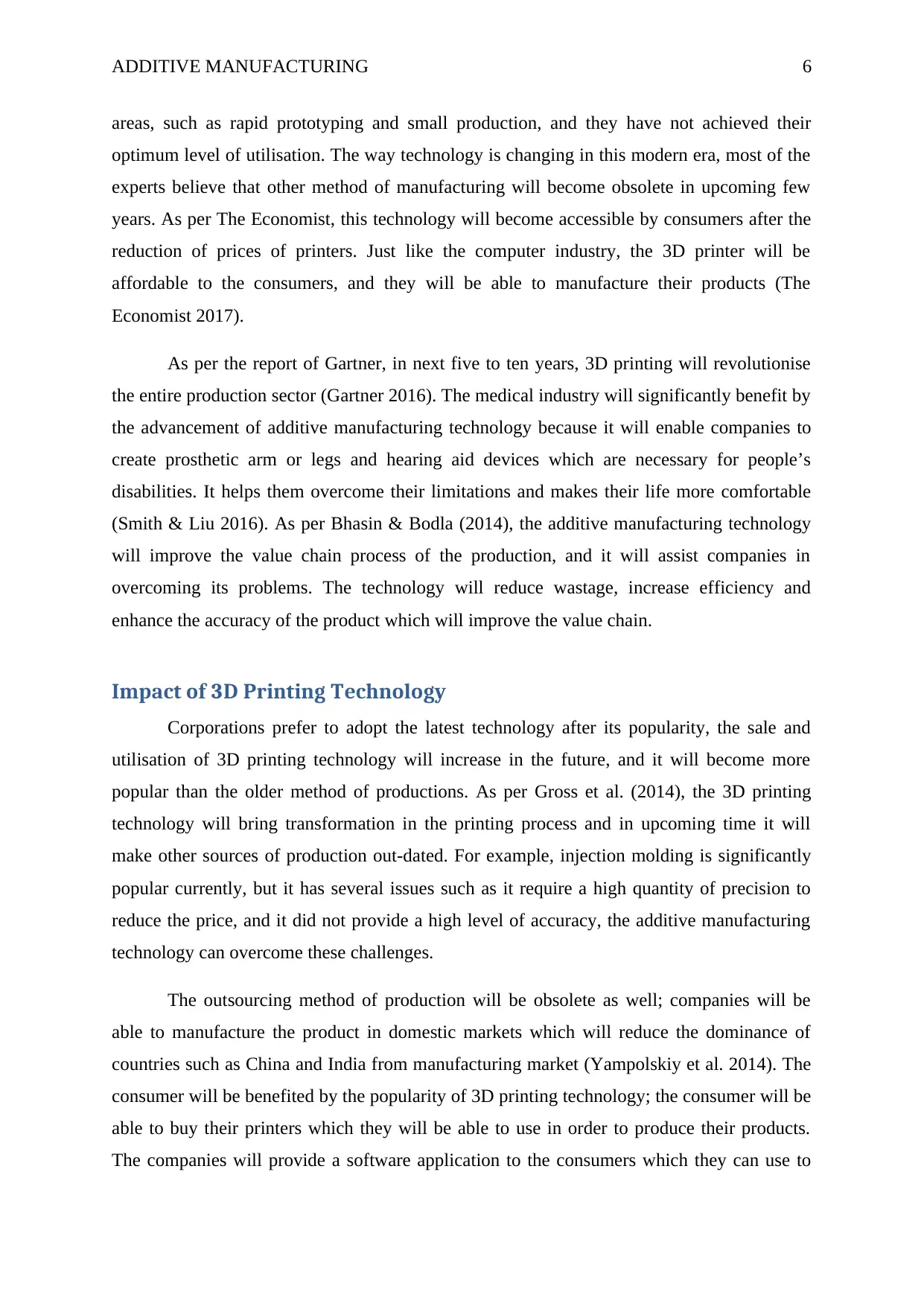
ADDITIVE MANUFACTURING 6
areas, such as rapid prototyping and small production, and they have not achieved their
optimum level of utilisation. The way technology is changing in this modern era, most of the
experts believe that other method of manufacturing will become obsolete in upcoming few
years. As per The Economist, this technology will become accessible by consumers after the
reduction of prices of printers. Just like the computer industry, the 3D printer will be
affordable to the consumers, and they will be able to manufacture their products (The
Economist 2017).
As per the report of Gartner, in next five to ten years, 3D printing will revolutionise
the entire production sector (Gartner 2016). The medical industry will significantly benefit by
the advancement of additive manufacturing technology because it will enable companies to
create prosthetic arm or legs and hearing aid devices which are necessary for people’s
disabilities. It helps them overcome their limitations and makes their life more comfortable
(Smith & Liu 2016). As per Bhasin & Bodla (2014), the additive manufacturing technology
will improve the value chain process of the production, and it will assist companies in
overcoming its problems. The technology will reduce wastage, increase efficiency and
enhance the accuracy of the product which will improve the value chain.
Impact of 3D Printing Technology
Corporations prefer to adopt the latest technology after its popularity, the sale and
utilisation of 3D printing technology will increase in the future, and it will become more
popular than the older method of productions. As per Gross et al. (2014), the 3D printing
technology will bring transformation in the printing process and in upcoming time it will
make other sources of production out-dated. For example, injection molding is significantly
popular currently, but it has several issues such as it require a high quantity of precision to
reduce the price, and it did not provide a high level of accuracy, the additive manufacturing
technology can overcome these challenges.
The outsourcing method of production will be obsolete as well; companies will be
able to manufacture the product in domestic markets which will reduce the dominance of
countries such as China and India from manufacturing market (Yampolskiy et al. 2014). The
consumer will be benefited by the popularity of 3D printing technology; the consumer will be
able to buy their printers which they will be able to use in order to produce their products.
The companies will provide a software application to the consumers which they can use to
areas, such as rapid prototyping and small production, and they have not achieved their
optimum level of utilisation. The way technology is changing in this modern era, most of the
experts believe that other method of manufacturing will become obsolete in upcoming few
years. As per The Economist, this technology will become accessible by consumers after the
reduction of prices of printers. Just like the computer industry, the 3D printer will be
affordable to the consumers, and they will be able to manufacture their products (The
Economist 2017).
As per the report of Gartner, in next five to ten years, 3D printing will revolutionise
the entire production sector (Gartner 2016). The medical industry will significantly benefit by
the advancement of additive manufacturing technology because it will enable companies to
create prosthetic arm or legs and hearing aid devices which are necessary for people’s
disabilities. It helps them overcome their limitations and makes their life more comfortable
(Smith & Liu 2016). As per Bhasin & Bodla (2014), the additive manufacturing technology
will improve the value chain process of the production, and it will assist companies in
overcoming its problems. The technology will reduce wastage, increase efficiency and
enhance the accuracy of the product which will improve the value chain.
Impact of 3D Printing Technology
Corporations prefer to adopt the latest technology after its popularity, the sale and
utilisation of 3D printing technology will increase in the future, and it will become more
popular than the older method of productions. As per Gross et al. (2014), the 3D printing
technology will bring transformation in the printing process and in upcoming time it will
make other sources of production out-dated. For example, injection molding is significantly
popular currently, but it has several issues such as it require a high quantity of precision to
reduce the price, and it did not provide a high level of accuracy, the additive manufacturing
technology can overcome these challenges.
The outsourcing method of production will be obsolete as well; companies will be
able to manufacture the product in domestic markets which will reduce the dominance of
countries such as China and India from manufacturing market (Yampolskiy et al. 2014). The
consumer will be benefited by the popularity of 3D printing technology; the consumer will be
able to buy their printers which they will be able to use in order to produce their products.
The companies will provide a software application to the consumers which they can use to
Paraphrase This Document
Need a fresh take? Get an instant paraphrase of this document with our AI Paraphraser

ADDITIVE MANUFACTURING 7
build their products in their home. Therefore, the technology will be significantly benefited
for the consumers, and it will bring them closer to the production procedure.
build their products in their home. Therefore, the technology will be significantly benefited
for the consumers, and it will bring them closer to the production procedure.
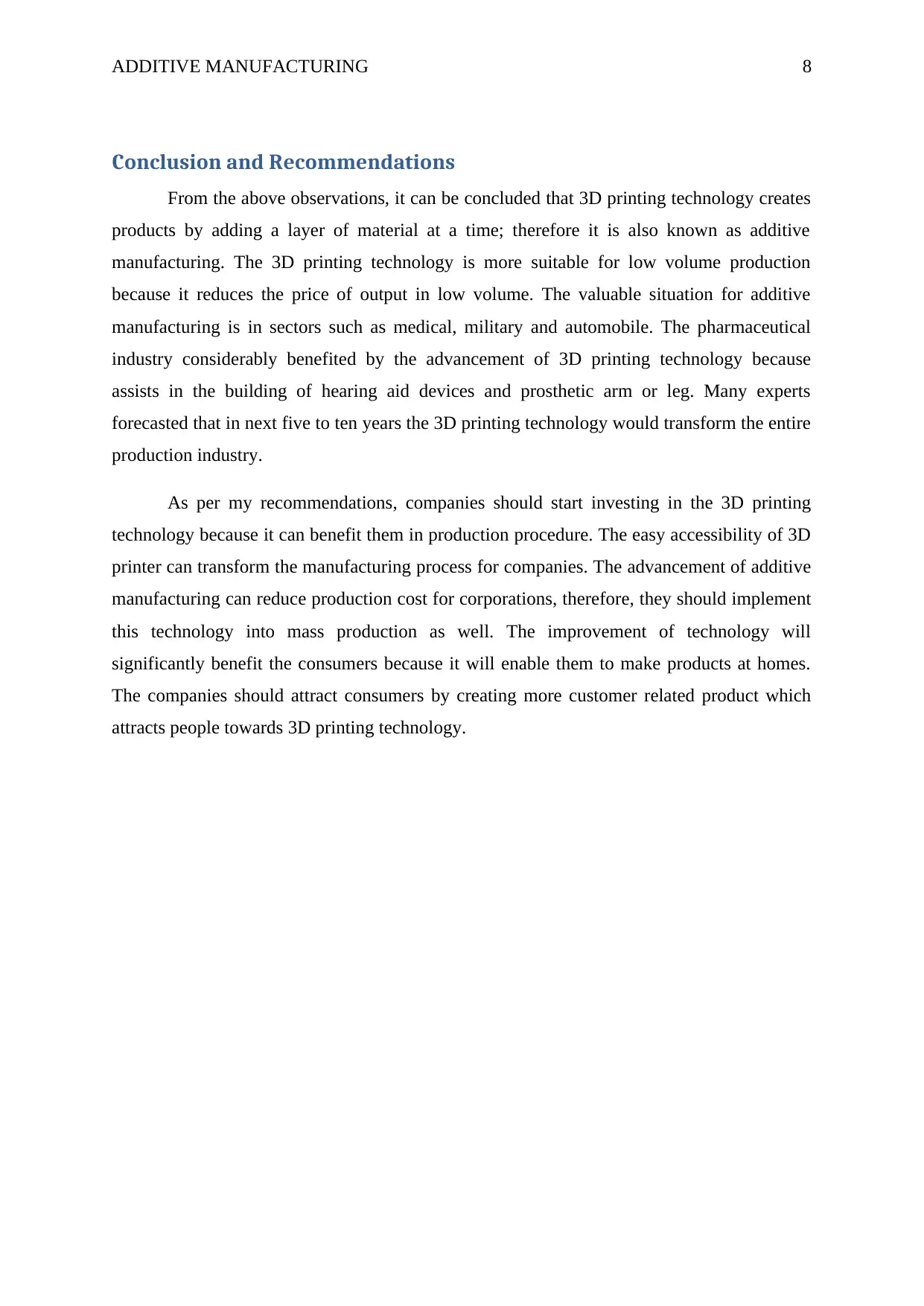
ADDITIVE MANUFACTURING 8
Conclusion and Recommendations
From the above observations, it can be concluded that 3D printing technology creates
products by adding a layer of material at a time; therefore it is also known as additive
manufacturing. The 3D printing technology is more suitable for low volume production
because it reduces the price of output in low volume. The valuable situation for additive
manufacturing is in sectors such as medical, military and automobile. The pharmaceutical
industry considerably benefited by the advancement of 3D printing technology because
assists in the building of hearing aid devices and prosthetic arm or leg. Many experts
forecasted that in next five to ten years the 3D printing technology would transform the entire
production industry.
As per my recommendations, companies should start investing in the 3D printing
technology because it can benefit them in production procedure. The easy accessibility of 3D
printer can transform the manufacturing process for companies. The advancement of additive
manufacturing can reduce production cost for corporations, therefore, they should implement
this technology into mass production as well. The improvement of technology will
significantly benefit the consumers because it will enable them to make products at homes.
The companies should attract consumers by creating more customer related product which
attracts people towards 3D printing technology.
Conclusion and Recommendations
From the above observations, it can be concluded that 3D printing technology creates
products by adding a layer of material at a time; therefore it is also known as additive
manufacturing. The 3D printing technology is more suitable for low volume production
because it reduces the price of output in low volume. The valuable situation for additive
manufacturing is in sectors such as medical, military and automobile. The pharmaceutical
industry considerably benefited by the advancement of 3D printing technology because
assists in the building of hearing aid devices and prosthetic arm or leg. Many experts
forecasted that in next five to ten years the 3D printing technology would transform the entire
production industry.
As per my recommendations, companies should start investing in the 3D printing
technology because it can benefit them in production procedure. The easy accessibility of 3D
printer can transform the manufacturing process for companies. The advancement of additive
manufacturing can reduce production cost for corporations, therefore, they should implement
this technology into mass production as well. The improvement of technology will
significantly benefit the consumers because it will enable them to make products at homes.
The companies should attract consumers by creating more customer related product which
attracts people towards 3D printing technology.
⊘ This is a preview!⊘
Do you want full access?
Subscribe today to unlock all pages.

Trusted by 1+ million students worldwide
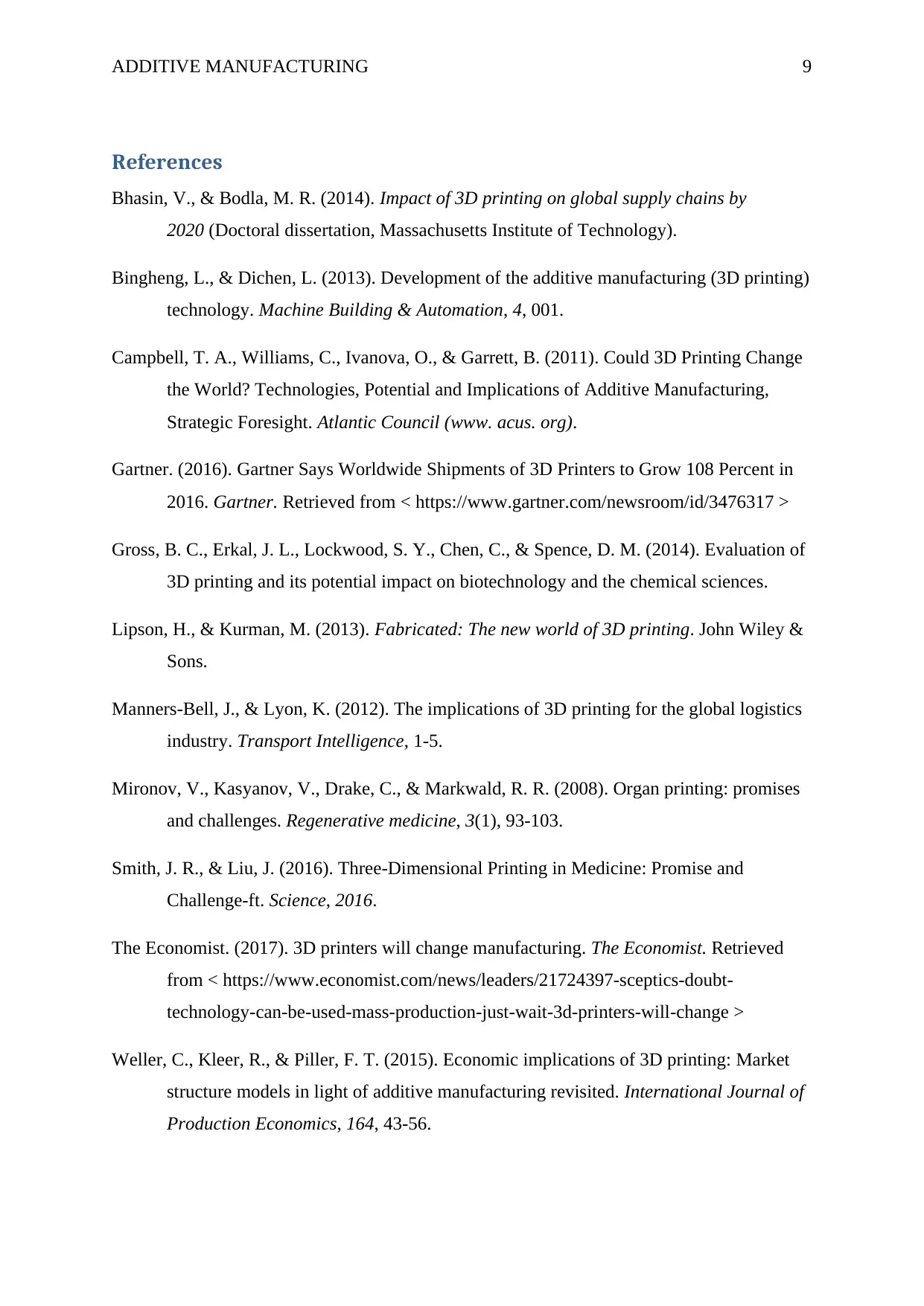
ADDITIVE MANUFACTURING 9
References
Bhasin, V., & Bodla, M. R. (2014). Impact of 3D printing on global supply chains by
2020 (Doctoral dissertation, Massachusetts Institute of Technology).
Bingheng, L., & Dichen, L. (2013). Development of the additive manufacturing (3D printing)
technology. Machine Building & Automation, 4, 001.
Campbell, T. A., Williams, C., Ivanova, O., & Garrett, B. (2011). Could 3D Printing Change
the World? Technologies, Potential and Implications of Additive Manufacturing,
Strategic Foresight. Atlantic Council (www. acus. org).
Gartner. (2016). Gartner Says Worldwide Shipments of 3D Printers to Grow 108 Percent in
2016. Gartner. Retrieved from < https://www.gartner.com/newsroom/id/3476317 >
Gross, B. C., Erkal, J. L., Lockwood, S. Y., Chen, C., & Spence, D. M. (2014). Evaluation of
3D printing and its potential impact on biotechnology and the chemical sciences.
Lipson, H., & Kurman, M. (2013). Fabricated: The new world of 3D printing. John Wiley &
Sons.
Manners-Bell, J., & Lyon, K. (2012). The implications of 3D printing for the global logistics
industry. Transport Intelligence, 1-5.
Mironov, V., Kasyanov, V., Drake, C., & Markwald, R. R. (2008). Organ printing: promises
and challenges. Regenerative medicine, 3(1), 93-103.
Smith, J. R., & Liu, J. (2016). Three-Dimensional Printing in Medicine: Promise and
Challenge-ft. Science, 2016.
The Economist. (2017). 3D printers will change manufacturing. The Economist. Retrieved
from < https://www.economist.com/news/leaders/21724397-sceptics-doubt-
technology-can-be-used-mass-production-just-wait-3d-printers-will-change >
Weller, C., Kleer, R., & Piller, F. T. (2015). Economic implications of 3D printing: Market
structure models in light of additive manufacturing revisited. International Journal of
Production Economics, 164, 43-56.
References
Bhasin, V., & Bodla, M. R. (2014). Impact of 3D printing on global supply chains by
2020 (Doctoral dissertation, Massachusetts Institute of Technology).
Bingheng, L., & Dichen, L. (2013). Development of the additive manufacturing (3D printing)
technology. Machine Building & Automation, 4, 001.
Campbell, T. A., Williams, C., Ivanova, O., & Garrett, B. (2011). Could 3D Printing Change
the World? Technologies, Potential and Implications of Additive Manufacturing,
Strategic Foresight. Atlantic Council (www. acus. org).
Gartner. (2016). Gartner Says Worldwide Shipments of 3D Printers to Grow 108 Percent in
2016. Gartner. Retrieved from < https://www.gartner.com/newsroom/id/3476317 >
Gross, B. C., Erkal, J. L., Lockwood, S. Y., Chen, C., & Spence, D. M. (2014). Evaluation of
3D printing and its potential impact on biotechnology and the chemical sciences.
Lipson, H., & Kurman, M. (2013). Fabricated: The new world of 3D printing. John Wiley &
Sons.
Manners-Bell, J., & Lyon, K. (2012). The implications of 3D printing for the global logistics
industry. Transport Intelligence, 1-5.
Mironov, V., Kasyanov, V., Drake, C., & Markwald, R. R. (2008). Organ printing: promises
and challenges. Regenerative medicine, 3(1), 93-103.
Smith, J. R., & Liu, J. (2016). Three-Dimensional Printing in Medicine: Promise and
Challenge-ft. Science, 2016.
The Economist. (2017). 3D printers will change manufacturing. The Economist. Retrieved
from < https://www.economist.com/news/leaders/21724397-sceptics-doubt-
technology-can-be-used-mass-production-just-wait-3d-printers-will-change >
Weller, C., Kleer, R., & Piller, F. T. (2015). Economic implications of 3D printing: Market
structure models in light of additive manufacturing revisited. International Journal of
Production Economics, 164, 43-56.
Paraphrase This Document
Need a fresh take? Get an instant paraphrase of this document with our AI Paraphraser
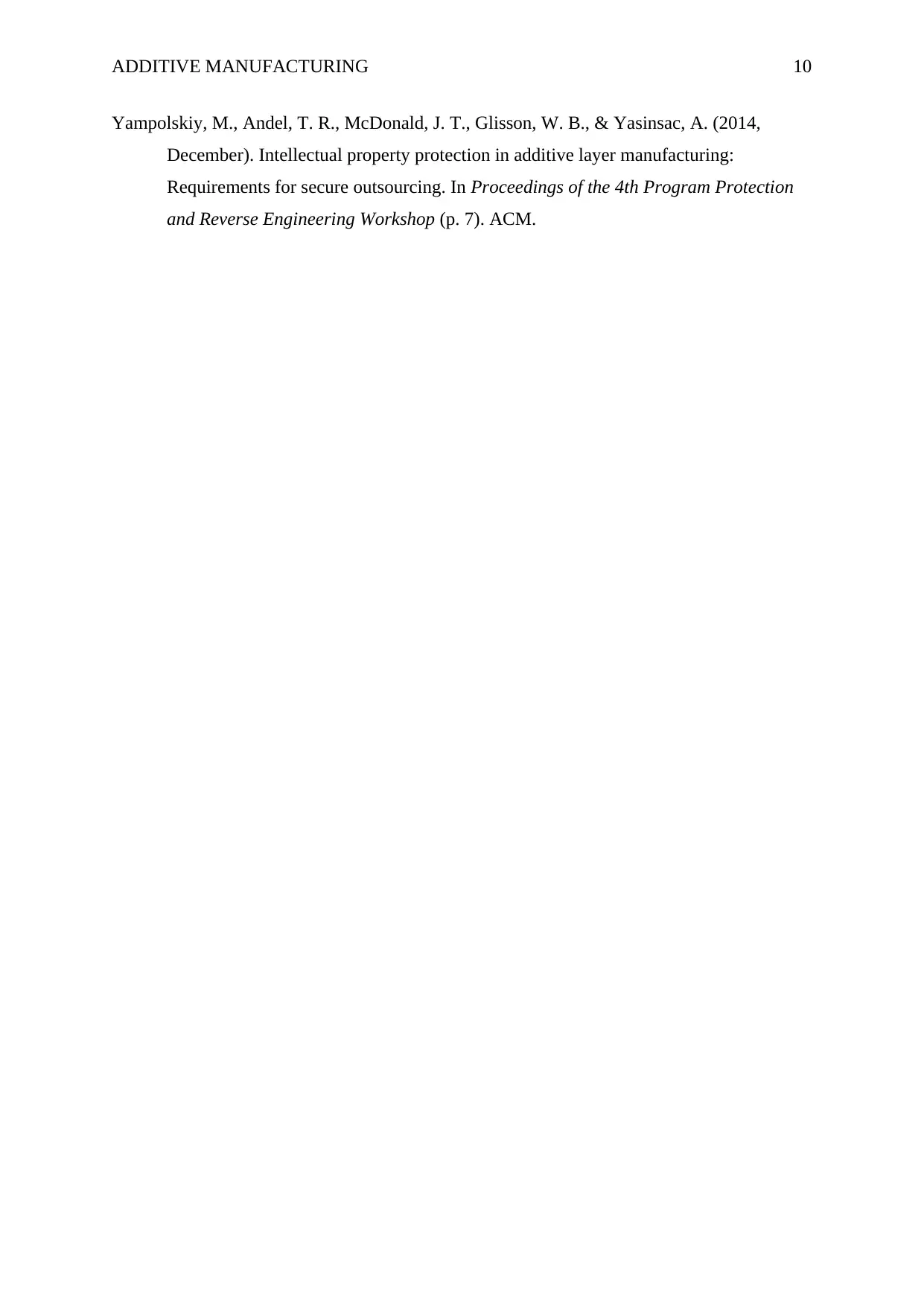
ADDITIVE MANUFACTURING 10
Yampolskiy, M., Andel, T. R., McDonald, J. T., Glisson, W. B., & Yasinsac, A. (2014,
December). Intellectual property protection in additive layer manufacturing:
Requirements for secure outsourcing. In Proceedings of the 4th Program Protection
and Reverse Engineering Workshop (p. 7). ACM.
Yampolskiy, M., Andel, T. R., McDonald, J. T., Glisson, W. B., & Yasinsac, A. (2014,
December). Intellectual property protection in additive layer manufacturing:
Requirements for secure outsourcing. In Proceedings of the 4th Program Protection
and Reverse Engineering Workshop (p. 7). ACM.
1 out of 11
Related Documents
Your All-in-One AI-Powered Toolkit for Academic Success.
+13062052269
info@desklib.com
Available 24*7 on WhatsApp / Email
![[object Object]](/_next/static/media/star-bottom.7253800d.svg)
Unlock your academic potential
Copyright © 2020–2025 A2Z Services. All Rights Reserved. Developed and managed by ZUCOL.





